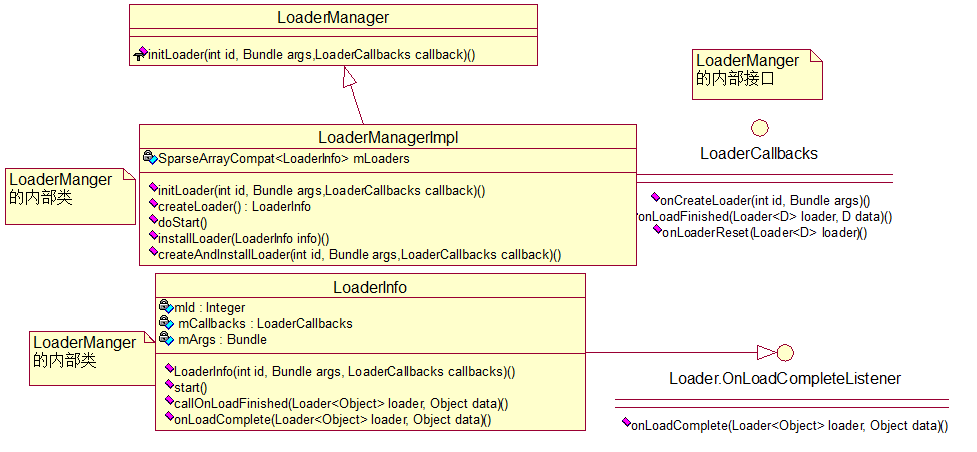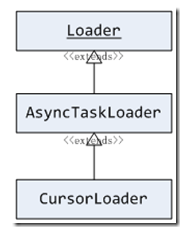Android Loader详解
来源:互联网 发布:怎么自学java 编辑:程序博客网 时间:2024/04/30 06:53
原文:http://blog.csdn.net/luohai859/article/details/23938291
在看Android的文档时,看到了这么一个东西: Loader
究竟是什么东西呢?
Introduced in Android 3.0, loaders make it easy to asynchronously load data in an activity or fragment. Loaders have these characteristics:
1、They are available to every Activity and Fragment. //支持Activity和Fragment
2、They provide asynchronous loading of data. //异步下载
3、They monitor the source of their data and deliver new results when the content changes. //当数据源改变时能及时通知客户端
4、They automatically reconnect to the last loader's cursor when being recreated after a configuration change. Thus, they don't need to re-query their data. //发生configuration change时自动重连接
看来这东西蛮强大的,开始我的探索之路吧.
先简单看一下它的用法先:
001/**002 * Demonstration of the use of a CursorLoader to load and display contacts003 * data in a fragment.004 */005public classLoaderCursorextendsActivity {006 007 @Override008 protectedvoidonCreate(Bundle savedInstanceState) {009 super.onCreate(savedInstanceState);010 011 FragmentManager fm = getFragmentManager();012 013 // Create the list fragment and add it as our sole content.014 if(fm.findFragmentById(android.R.id.content) ==null) {015 CursorLoaderListFragment list =newCursorLoaderListFragment();016 fm.beginTransaction().add(android.R.id.content, list).commit();017 }018 }019 020 021 publicstaticclassCursorLoaderListFragment extendsListFragment022 implementsLoaderManager.LoaderCallbacks<Cursor> {023 024 // This is the Adapter being used to display the list's data.025 SimpleCursorAdapter mAdapter;026 027 // If non-null, this is the current filter the user has provided.028 String mCurFilter;029 030 @OverridepublicvoidonActivityCreated(Bundle savedInstanceState) {031 032 mAdapter =newSimpleCursorAdapter(getActivity(),033 android.R.layout.simple_list_item_2,null,034 newString[] { Contacts.DISPLAY_NAME, Contacts.CONTACT_STATUS },035 newint[] { android.R.id.text1, android.R.id.text2 },0);036 setListAdapter(mAdapter);037 038 getLoaderManager().initLoader(0,null,this);039 }040 041 042 @OverridepublicvoidonListItemClick(ListView l, View v,intposition, longid) {043 // Insert desired behavior here.044 Log.i("FragmentComplexList","Item clicked: "+ id);045 }046 047 // These are the Contacts rows that we will retrieve.048 staticfinalString[] CONTACTS_SUMMARY_PROJECTION =newString[] {049 Contacts._ID,050 Contacts.DISPLAY_NAME,051 Contacts.CONTACT_STATUS,052 Contacts.CONTACT_PRESENCE,053 Contacts.PHOTO_ID,054 Contacts.LOOKUP_KEY,055 };056 057 publicLoader<Cursor> onCreateLoader(intid, Bundle args) {058 // This is called when a new Loader needs to be created. This059 // sample only has one Loader, so we don't care about the ID.060 // First, pick the base URI to use depending on whether we are061 // currently filtering.062 Uri baseUri;063 if(mCurFilter !=null) {064 baseUri = Uri.withAppendedPath(Contacts.CONTENT_FILTER_URI,065 Uri.encode(mCurFilter));066 }else{067 baseUri = Contacts.CONTENT_URI;068 }069 070 // Now create and return a CursorLoader that will take care of071 // creating a Cursor for the data being displayed.072 String select ="(("+ Contacts.DISPLAY_NAME +" NOTNULL) AND ("073 + Contacts.HAS_PHONE_NUMBER +"=1) AND ("074 + Contacts.DISPLAY_NAME +" != '' ))";075 returnnewCursorLoader(getActivity(), baseUri,076 CONTACTS_SUMMARY_PROJECTION, select,null,077 Contacts.DISPLAY_NAME +" COLLATE LOCALIZED ASC");078 }079 080 publicvoidonLoadFinished(Loader<Cursor> loader, Cursor data) {081 // Swap the new cursor in. (The framework will take care of closing the082 // old cursor once we return.)083 mAdapter.swapCursor(data);084 085 // The list should now be shown.086 if(isResumed()) {087 setListShown(true);088 }else{089 setListShownNoAnimation(true);090 }091 }092 093 publicvoidonLoaderReset(Loader<Cursor> loader) {094 // This is called when the last Cursor provided to onLoadFinished()095 // above is about to be closed. We need to make sure we are no096 // longer using it.097 mAdapter.swapCursor(null);098 }099 }100 101}这里是Android提供的实例代码,有删减。
从代码上看来,通过实现LoaderManager.LoaderCallbacks就行了.
在onCreateLoader里面实现你要请求的耗时操作,当异步线程操作完成之后就会从onLoadFinished返回数据.
用起来是不是很简单呢?下面具体来看一下它是怎么做到的吧.
getLoaderManager()是定义在Activity类的一个方法,返回类型LoaderManager,但这只是个接口,它真正的实现类是谁呢?
继续往下走,看到这个LoaderManagerImpl getLoaderManager(String who, boolean started, boolean create),方法时,答案便揭晓了.
下面我们来看看LoaderManager相关的类结构,省略了很多东西,但不影响我们的分析.

现在我们来到了LoaderManagerImp的initLoader方法了.
01public <D> Loader<D> initLoader(intid, Bundle args, LoaderManager.LoaderCallbacks<D> callback) {02 if(mCreatingLoader) {03 thrownewIllegalStateException("Called while creating a loader");04 }05 06 LoaderInfo info = mLoaders.get(id);07 08 if(info ==null) {09 // Loader doesn't already exist; create.10 info = createAndInstallLoader(id, args, (LoaderManager.LoaderCallbacks<Object>)callback);11 if(DEBUG) Log.v(TAG," Created new loader "+ info);12 } else {13 if(DEBUG) Log.v(TAG," Re-using existing loader "+ info);14 info.mCallbacks = (LoaderManager.LoaderCallbacks<Object>)callback;15 }16 17 if(info.mHaveData && mStarted) {18 // If the loader has already generated its data, report it now.19 info.callOnLoadFinished(info.mLoader, info.mData);20 }21 22 return(Loader<D>)info.mLoader;23}这是一个新的Loader,那么info应该是null,转入执行createAndInstallLoader.
01private LoaderInfo createAndInstallLoader(intid, Bundle args,02 LoaderManager.LoaderCallbacks<Object> callback) {03 try{04 mCreatingLoader =true;05 LoaderInfo info = createLoader(id, args, callback);06 installLoader(info);07 returninfo;08 } finally {09 mCreatingLoader =false;10 }11 }12 13 privateLoaderInfo createLoader(intid, Bundle args,14 LoaderManager.LoaderCallbacks<Object> callback) {15 LoaderInfo info =newLoaderInfo(id, args, (LoaderManager.LoaderCallbacks<Object>)callback);16 Loader<Object> loader = callback.onCreateLoader(id, args);17 info.mLoader = (Loader<Object>)loader;18 returninfo;19 }20 21 voidinstallLoader(LoaderInfo info) {22 mLoaders.put(info.mId, info);23 if(mStarted) {24 // The activity will start all existing loaders in it's onStart(),25 // so only start them here if we're past that point of the activitiy's26 // life cycle27 info.start();28 }29 }createLoader把必要的信息都封装在LoaderInfo类里面,留意以下这一行:
callback.onCreateLoader(id,arg),这里正是我们上面在客户端实现接口LoaderCallback的那个方法.
接着调用installLoader,这个方法把这次Loader的信息put进mLoader这个SparseArray<LoaderInfo>中,这个对象可以理解为一个Map,它的性能比Map要好.
mStarted的值是true,它是在getLoaderManager的时候在Activity中传进来的true值.
好了,下面进入LoaderInfo的start方法了.
01void start() {02 if(mLoader !=null) {03 04 if(!mListenerRegistered) {05 mLoader.registerListener(mId,this);06 mListenerRegistered =true;07 }08 mLoader.startLoading();09 }10 }mLoader就是在客户端实现的那个Loader,回到我们刚开始时的例子,它就是一个CursorLoader.
在分析CursorLoader的startLoading之前,我们先看一下这些Loader的类结构先:

从这些类的名称看来,真正实现了异步传输功能的类应该就是AsyncTaskLoader了,事实是不是这样呢?
继续深入下去:
这里的startLoading是调用了Loader类的方法,下文中我会用这样的方法来标识方法是属于哪个类的: 如Loader –> startLoading
01Loader:02 publicfinalvoidstartLoading() {03 mStarted =true;04 mReset =false;05 mAbandoned =false;06 onStartLoading();07 }08 09 CursorLoader:10 protectedvoidonStartLoading() {11 if(mCursor !=null) {12 deliverResult(mCursor);13 }14 if(takeContentChanged() || mCursor ==null) {15 forceLoad();16 }17 }18 19 AsynTaskLoader:20 protectedvoidonForceLoad() {21 super.onForceLoad();22 cancelLoad();23 mTask =newLoadTask();24 if(DEBUG) Slog.v(TAG,"Preparing load: mTask="+ mTask);25 executePendingTask();26 }终于看到了LoadTask关键字啦,答案就要揭晓啦.
01AsyncTaskLoader:02final classLoadTaskextendsAsyncTask<Void, Void, D>implementsRunnable {03 privatefinalCountDownLatch mDone =newCountDownLatch(1);04 05 // Set to true to indicate that the task has been posted to a handler for06 // execution at a later time. Used to throttle updates.07 booleanwaiting;08 09 /* Runs on a worker thread */10 @Override11 protected D doInBackground(Void... params) {12 if (DEBUG) Slog.v(TAG, this + " >>> doInBackground");13 try {14 D data = AsyncTaskLoader.this.onLoadInBackground();15 return data;16 } catch (OperationCanceledException ex) {17 }18 }19 20 /* Runs on the UI thread */21 @Override22 protectedvoidonPostExecute(D data) {23 if(DEBUG) Slog.v(TAG,this+ " onPostExecute");24 try{25 AsyncTaskLoader.this.dispatchOnLoadComplete(this, data);26 }finally{27 mDone.countDown();28 }29 }30 }31 32AsyncTaskLoader: 33protected D onLoadInBackground() {34 returnloadInBackground();35} 36 37CursorLoader:38public Cursor loadInBackground() {39 try{40 Cursor cursor = getContext().getContentResolver().query(mUri, mProjection, mSelection,41 mSelectionArgs, mSortOrder, mCancellationSignal);42 if(cursor !=null) {43 // Ensure the cursor window is filled44 cursor.getCount();45 registerContentObserver(cursor, mObserver);46 }47 returncursor;48 } finally {49 synchronized(this) {50 mCancellationSignal =null;51 }52 53}LoadTask原来是个AsyncTask类型,看到这里大家大家应该觉得有种豁然的感觉了吧.
在ForceLoad里面启动该线程,开始执行doInBackground,回调CursorLoader里面的loadInBackgroud,这个方法里面执行真正的耗时操作,
执行完之后一层一层返回,接着调用onPostExecute方法.
好了,现在数据总算是拿到了.
接着执行,把获取的数据往回调.
LoadTask -> onPostExecute
----->
AsynTaskLoader-> dispatchOnLoadComplete
----->
Loader->deliverResult
回调前面注册的loadComplete:
LoaderInfo -> onLoadComplete
---->
LoaderInfo ->callOnLoadFinished
把数据回调给客户端
mCallbacks.onLoadFinished(loader, data);
到这里就完美解释了Loader的特点2,异步
第三点当数据源改变时能及时通知客户端又是如何体现的呢?
这里用了观察者模式来实现.我们先看一下CursorLoader的构造函数:
mObserver = new ForceLoadContentObserver();
这个ForceLoadContentObserver是什么东西呢?
ForceLoadContentObserver继承了ContentObserver,这是Android内部的一个对象,继承了它,就能享受到数据变化时可以接收到通知(也就是观察者中的Subject),这里类似于数据库中的触发器.

先往下看:
在CursorLoader->loadInBackground方法中有这么一句:
registerContentObserver(cursor, mObserver);//注册观察者
答案揭晓了.
注册观察者后,当对应的URI发生变化是,会触发onChange方法
01public voidonChange(booleanselfChange) {02 onContentChanged();03}04 05public voidonContentChanged() {06 if(mStarted) {07 forceLoad(); //这里重新发送请求.08 } else {09 // This loader has been stopped, so we don't want to load10 // new data right now... but keep track of it changing to11 // refresh later if we start again.12 mContentChanged =true;13 }14}对于forceLoad方法前面已经提高过了,大家应该还有印象吧.
最后一个问题,也就是第四点:如何做到在configuration change自动重链接的呢?
只要能回答这两个问题,这个问题就解决了.
<1>loader如何在configuration change之前保存数据?
<2>loader如何在configuration chage之后恢复数据并继续load?
LoaderManager:
还记得吗?Loader创建之初,在LoaderManagerImp->installLoader方法里面,
mLoaders.put(info.mId, info);
Info 是LoaderInfo对象,里面封装了Loader的相关信息,表示这个LoaderInfo的Key是mId.
就是在这里保存了loader.这样就回答了问题<1>
对于问题二,首先我们来了解一下configuration change发生之后会发生什么事情呢?
还记得这个生命周期图吗,Fragment的也是差不多的.
当configuration change发生之后,会先把原来的Activity销毁掉,然后再重新构建一个,
也就是会重走一遍onCreate->onStart->onResume的过程.
(会有其他情况,参照 Activity的ConfigChanges属性)
好了,明白这个之后,我在onStart方法里面找到了线索.
01Activity:02 protectedvoidonStart() {03 if(DEBUG_LIFECYCLE) Slog.v(TAG,"onStart "+this);04 mCalled =true;05 06 if(!mLoadersStarted) {07 mLoadersStarted =true;08 if(mLoaderManager !=null) {09 mLoaderManager.doStart();10 }elseif(!mCheckedForLoaderManager) {11 mLoaderManager = getLoaderManager(null, mLoadersStarted,false);12 }13 mCheckedForLoaderManager =true;14 }15 16 getApplication().dispatchActivityStarted(this);17 }18 19 LoaderManagerImp:20 voiddoStart() {21 if(DEBUG) Log.v(TAG,"Starting in "+this);22 if(mStarted) {23 RuntimeException e =newRuntimeException("here");24 e.fillInStackTrace();25 Log.w(TAG,"Called doStart when already started: "+this, e);26 return;27 }28 29 mStarted =true;30 31 // Call out to sub classes so they can start their loaders32 // Let the existing loaders know that we want to be notified when a load is complete33 for(inti = mLoaders.size()-1; i >=0; i--) {34 mLoaders.valueAt(i).start();35 }36 }
留意doStart的For循环,真相大白了..
最后总结一下:
1、异步是通过AsynTaskLoader来实现的。
2、通过观察者模式来实现监控数据的变化.
3、通过Activity生命周期中的onStart来实现自动重连接.
第二个文章
原文: http://blog.sina.com.cn/s/blog_62c5894901014g5x.html
Google倒是提供了一个标准的Loader,即CursorLoader,它是Loader的标准实现,如果你的数据能够用Cursor表示,比如来自SQLiteDatabase的数据就是标准的Cursor,那么这个类对你而言就够用了,具体如何使用CursorLoader,请参看如下两个例子:
http://developer.android.com/resources/samples/ApiDemos/src/com/example/android/apis/app/LoaderThrottle.html
这个例子中牵涉的东西较多,除了我们关注的CursorLoader外,还包括ContentProvider、SQLiteOperHelper、SQLiteDatabase、Fragment、Uri等等常用概念,因此,在仔细阅读了本例后,你将学会如何让这这些类在你的应用中分工协作。
http://developer.android.com/resources/samples/ApiDemos/src/com/example/android/apis/app/LoaderCursor.html
这个例子要简单些,它教你如何获取联系人,虽然简单,却切中要害。
本文若是只关注这些,就没有意思了,毕竟在很多情况下,我们会感觉CursorLoader不顺眼,于是想写一个属于自己的、更帅的Loader,此时抽象类AsyncTaskLoader就会叫嚣着粉墨登场了,该抽象类定义了你的加载器异步加载数据需要实现的接口,那么如何实现呢?你可以去看下面的例子:
http://developer.android.com/reference/android/content/AsyncTaskLoader.html#loadInBackground()
为了让你以及我自己更好的学习自定义Loader这一伎俩,我把里头的关键代码摘了出来,咱们共同分析一番:
public static class AppListLoaderextends AsyncTaskLoader<List<AppEntry>>{
}
诸位请看loadInBackground方法,这是Loader的核心方法,必须得重载,你要在这里头实现加载数据的功能,看看名字就知道,该方法将在后台运行,这方法没有什么特别说的,自己想加什么样的数据,自己清楚。
再看deliverResult方法,当数据到达客户端后,这个方法将被调用,该方法可以不重载,你可以在其中根据需要实现传递数据的逻辑,请注意例子中对两个状态的判断(注:编程,就得养成if的好习惯),一个是isReset()这个方法用来判断Loader是否已经被重置,如果重置了,那么留着资源也没有啥用了,得把它释放掉;一个是isStarted(),如果Loader被启动那么就把数据传递出去:直接调super的传递方法就OK。
onStartLoading方法,必须得重载,且别忘记在里头调用forceLoad方法,你也看到,在例子中人家调用了deliverResult方法,并且创建了一个观察者来接收数据,在调用forceLoad时,请注意相应的条件判断- android loader 详解
- Android Loader详解
- android loader使用详解
- android loader 详解
- Android Loader详解
- Android Loader详解
- android loader 详解
- Android Loader详解
- Android Loader详解
- Android Loader详解
- android loader使用详解
- Android基础--Android Loader详解
- Android Loader详解一:概述
- Android Loader详解一:概述
- Android Loader详解一:概述
- Android Loader详解一:概述
- Android Loader详解一:概述
- Android-Universal-Image-Loader详解
- 阿里oss
- Fast RCNN 训练自己的数据集(3训练和检测)
- 数据结构与算法——无权最短路径算法的C++实现
- tomcat内置连接池管理
- 单例模式,工厂模式,代理模式汇总
- Android Loader详解
- Android5.0查看应用使用情况的权限
- 虚幻4 String2Asset String2Class String2Object
- 2015 Objective-C 三大新特性
- 【Linux学习笔记六】进程管理
- untiy 3d ShaderLab_第6章_VertexLit渲染路径_1_顶点照明
- BZOJ 2005([Noi2010]能量采集-数论)
- Elisp 入门笔记(1)
- swift 懒加载


